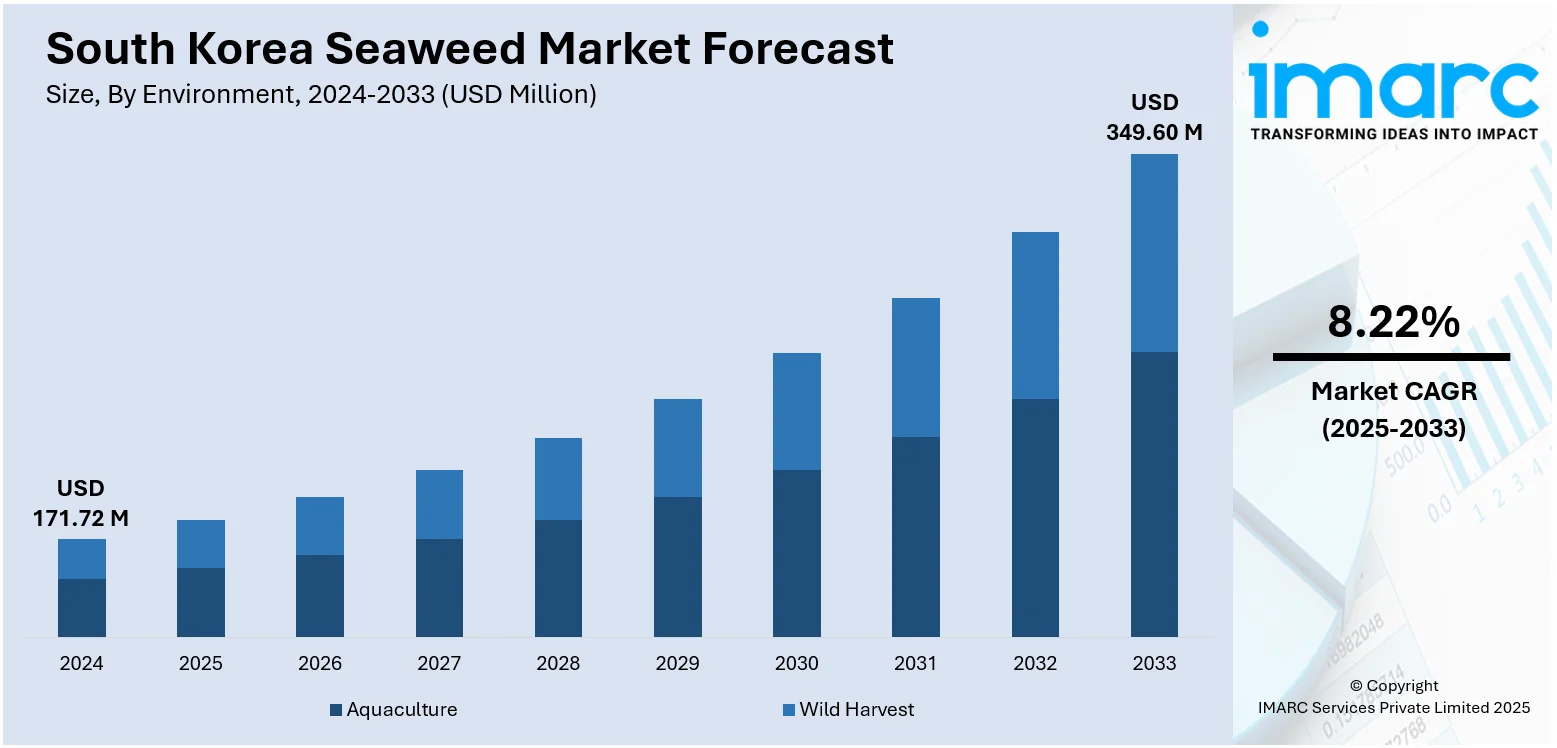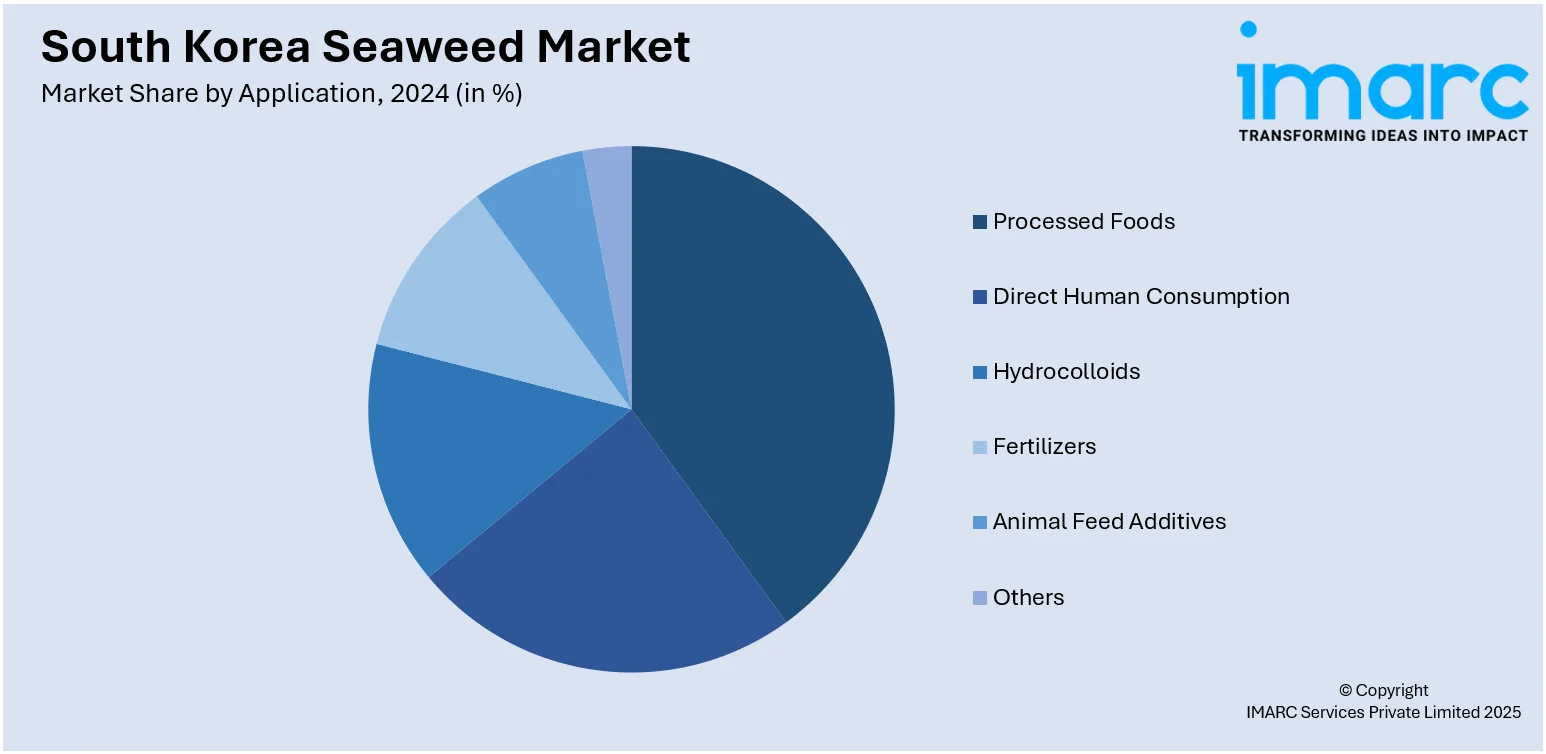
South Korea Seaweed Market Size, Share, Trends and Forecast by Environment, Product, Application, and Region, 2025-2033
South Korea Seaweed Market Overview:
The South Korea seaweed market size reached USD 171.72 Million in 2024. The market is projected to reach USD 349.60 Million by 2033, exhibiting a growth rate (CAGR) of 8.22% during 2025-2033. At present, with the growing interest in Korean seaweed offerings like roasted snacks, dried sheets, and health supplements, domestic manufacturers are enhancing cultivation efforts and refining processing techniques. Besides this, increasing demand for functional ingredients in cosmetic and skincare products is contributing to the expansion of the South Korea seaweed market share.
|
Report Attribute
|
Key Statistics
|
|---|---|
|
Base Year
|
2024 |
|
Forecast Years
|
2025-2033
|
|
Historical Years
|
2019-2024
|
| Market Size in 2024 | USD 171.72 Million |
| Market Forecast in 2033 | USD 349.60 Million |
| Market Growth Rate 2025-2033 | 8.22% |
South Korea Seaweed Market Trends:
Expansion of seaweed exports
The expansion of seaweed exports is positively influencing the market in South Korea. According to the information provided by the Korea Agro-Fisheries & Food Trade Corporation (aT), during Q1 2024, South Korea's seaweed exports achieved record levels, witnessing an impressive 21.1% rise in export value compared to Q1 2023. As the international demand is increasing for Korean seaweed products, such as roasted seaweed snacks, dried sheets, and seaweed-based health supplements, local producers are responding by scaling up cultivation and improving processing methods. Export markets like the United States, China, Japan, and Southeast Asia are showing strong interest in the Korean seaweed due to its taste, nutritional value, and association with Korean cuisine. This export momentum is encouraging local farmers and companies to adopt more efficient and sustainable farming practices to meet worldwide standards. Government support through trade agreements, quality certifications, and marketing campaigns is further enhancing the competitiveness of Korean seaweed in international markets. The rising popularity of Korean food culture also plays a role in increasing overseas interest. As more people worldwide are seeking healthy and low-calorie plant-based snacks, Korean seaweed is becoming a preferred choice, boosting export volumes. Companies are diversifying their product lines to suit foreign tastes, driving research and development (R&D) activities in the sector. Export success is contributing to steady income for coastal communities and promoting regional economic development.

To get more information on this market, Request Sample
Growing applications in cosmetic and skincare products
Rising applications in cosmetic and skincare items are fueling the South Korea seaweed market growth. People are showing strong preferences for natural and functional ingredients, and seaweed fits this trend with its rich content of vitamins, minerals, antioxidants, and moisturizing compounds. Seaweed extracts are widely used in creams, masks, toners, and cleansers due to their hydrating, anti-aging, and skin-soothing properties. As the worldwide popularity of K-beauty is increasing, international cosmetic brands are adopting Korean seaweed-based formulas, further boosting domestic production and innovation. South Korean skincare companies continue to develop seaweed-based items to stay ahead in the competitive beauty market, catalyzing steady demand for high-quality, locally sourced seaweed. Coastal farmers are benefiting from contracts with cosmetic manufacturers, ensuring consistent income and encouraging sustainable farming practices. The beauty industry’s focus on clean and eco-friendly ingredients aligns with seaweed’s image as a natural and renewable resource. As the thriving cosmetic industry continues to favor ocean-derived ingredients, seaweed maintains a strong position as a key resource, reinforcing its importance in South Korea’s economy. According to the IMARC Group, the South Korea cosmetics market is set to attain USD 12,712.7 Million by 2033, exhibiting a growth rate (CAGR) of 5.3% during 2025-2033.
South Korea Seaweed Market Segmentation:
IMARC Group provides an analysis of the key trends in each segment of the market, along with forecasts at the country and regional levels for 2025-2033. Our report has categorized the market based on environment, product, and application.
Environment Insights:
- Aquaculture
- Wild Harvest
The report has provided a detailed breakup and analysis of the market based on the environment. This includes aquaculture and wild harvest.
Product Insights:
- Red
- Brown
- Green
A detailed breakup and analysis of the market based on the product have also been provided in the report. This includes red, brown, and green.
Application Insights:

- Processed Foods
- Direct Human Consumption
- Hydrocolloids
- Fertilizers
- Animal Feed Additives
- Others
A detailed breakup and analysis of the market based on the application have also been provided in the report. This includes processed foods, direct human consumption, hydrocolloids, fertilizers, animal feed additives, and others.
Regional Insights:
- Seoul Capital Area
- Yeongnam (Southeastern Region)
- Honam (Southwestern Region)
- Hoseo (Central Region)
- Others
The report has also provided a comprehensive analysis of all the major regional markets, which include Seoul Capital Area, Yeongnam (Southeastern Region), Honam (Southwestern Region), Hoseo (Central Region), and others.
Competitive Landscape:
The market research report has also provided a comprehensive analysis of the competitive landscape. Competitive analysis such as market structure, key player positioning, top winning strategies, competitive dashboard, and company evaluation quadrant has been covered in the report. Also, detailed profiles of all major companies have been provided.
South Korea Seaweed Market News:
- In November 2024, CJ CheilJedang and Pulmuone, South Korean food firms, declared that they spent money on land-based seaweed cultivation as part of a government initiative designed to lower disease risk and counteract the impacts of increasing seawater temperatures. The initiative, commencing in 2025, aimed to boost seaweed availability.
South Korea Seaweed Market Report Coverage:
| Report Features | Details |
|---|---|
| Base Year of the Analysis | 2024 |
| Historical Period | 2019-2024 |
| Forecast Period | 2025-2033 |
| Units | Million USD |
| Scope of the Report |
Exploration of Historical Trends and Market Outlook, Industry Catalysts and Challenges, Segment-Wise Historical and Future Market Assessment:
|
| Environments Covered | Aquaculture, Wild Harvest |
| Products Covered | Red, Brown, Green |
| Applications Covered | Processed Foods, Direct Human Consumption, Hydrocolloids, Fertilizers, Animal Feed Additives, Others |
| Regions Covered | Seoul Capital Area, Yeongnam (Southeastern Region), Honam (Southwestern Region), Hoseo (Central Region), Others |
| Customization Scope | 10% Free Customization |
| Post-Sale Analyst Support | 10-12 Weeks |
| Delivery Format | PDF and Excel through Email (We can also provide the editable version of the report in PPT/Word format on special request) |
Key Questions Answered in This Report:
- How has the South Korea seaweed market performed so far and how will it perform in the coming years?
- What is the breakup of the South Korea seaweed market on the basis of environment?
- What is the breakup of the South Korea seaweed market on the basis of product?
- What is the breakup of the South Korea seaweed market on the basis of application?
- What is the breakup of the South Korea seaweed market on the basis of region?
- What are the various stages in the value chain of the South Korea seaweed market?
- What are the key driving factors and challenges in the South Korea seaweed market?
- What is the structure of the South Korea seaweed market and who are the key players?
- What is the degree of competition in the South Korea seaweed market?
Key Benefits for Stakeholders:
- IMARC’s industry report offers a comprehensive quantitative analysis of various market segments, historical and current market trends, market forecasts, and dynamics of the South Korea seaweed market from 2019-2033.
- The research report provides the latest information on the market drivers, challenges, and opportunities in the South Korea seaweed market.
- Porter's five forces analysis assist stakeholders in assessing the impact of new entrants, competitive rivalry, supplier power, buyer power, and the threat of substitution. It helps stakeholders to analyze the level of competition within the South Korea seaweed industry and its attractiveness.
- Competitive landscape allows stakeholders to understand their competitive environment and provides an insight into the current positions of key players in the market.
Need more help?
- Speak to our experienced analysts for insights on the current market scenarios.
- Include additional segments and countries to customize the report as per your requirement.
- Gain an unparalleled competitive advantage in your domain by understanding how to utilize the report and positively impacting your operations and revenue.
- For further assistance, please connect with our analysts.
 Request Customization
Request Customization
 Speak to an Analyst
Speak to an Analyst
 Request Brochure
Request Brochure
 Inquire Before Buying
Inquire Before Buying




.webp)




.webp)












